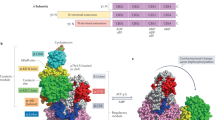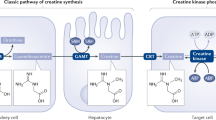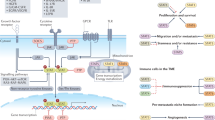Abstract
AMP-activated protein kinase (AMPK) and its upstream kinase, LKB1, act to both monitor and restore cellular energy in response to energy depletion. Studied extensively in liver and skeletal muscle, AMPK is phosphorylated and activated by LKB1 in response to increasing AMP/ATP ratios, which occur in a variety of settings including hypoxia, nutrient starvation and redox imbalance. Interest in the roles of both AMPK and LKB1 in cancer has grown substantially, following the identification of LKB1 as the tumor suppressor gene mutated in the Peutz–Jegher familial cancer syndrome. Patients with the Peutz–Jegher syndrome harbor a single inactive LKB1 gene, and acquisition of a second inactivating lesion (loss of heterozygosity) leads to the development of the cancer in a variety of organs. Thus, the loss of AMPK activation is hypothesized to promote the development of malignancy. Conversely, pharmacological AMPK activation has recently been shown to be cytotoxic to many established human cancer cell lines in vitro and in human cancer xenograft and mouse cancer allografts. Previously, changes in cell metabolism that accompanied the malignant phenotype have largely been considered a consequence of cellular transformation. Now, AMPK and energy metabolism are linked to the development and maintenance of the malignant phenotype. These findings have led to renewed interest in AMPK and cancer cell metabolism in general as potential targets for cancer therapy.
This is a preview of subscription content, access via your institution
Access options
Subscribe to this journal
Receive 12 print issues and online access
$259.00 per year
only $21.58 per issue
Buy this article
- Purchase on Springer Link
- Instant access to full article PDF
Prices may be subject to local taxes which are calculated during checkout


Similar content being viewed by others
References
Hardie C, Carling D, Carlson M . The AMP-activated/SNF1 protein kinase subfamily: metabolic sensors of the eukaryotic cell. Annu Rev Biochem 1998; 67: 821–855.
Kemp BE, Stapleton D, Campbell DJ, Chen ZP, Murthy S, Walter M et al. AMP-activated protein kinase, super metabolic regulator. Biochem Soc Trans 2003; 31: 162–168.
Mitchelhill KI, Michell BJ, House CM, Stapleton D, Dyck J, Gamble J et al. Posttranslational modifications of the 5′-AMP-activated protein kinase beta1 subunit. J Biol Chem 1997; 272: 24475–24479.
Corton JM, Gillespie JG, Hawley SA, Hardie DG . 5-aminoimidazole-4-carboxamide ribonucleoside. A specific method for activating AMP-activated protein kinase in intact cells? Eur J Biochem 1995; 229: 558–565.
Muoio DM, Seefeld K, Witters LA, Coleman RA . AMP-activated kinase reciprocally regulates triacylglycerol synthesis and fatty acid oxidation in liver and muscle: evidence that sn-glycerol-3-phosphate acyltransferase is a novel target. Biochem J 1999; 338 (Part 3): 783–791.
Marsin AS, Bertrand L, Rider MH, Deprez J, Beauloye C, Vincent MF et al. Phosphorylation and activation of heart PFK-2 by AMPK has a role in the stimulation of glycolysis during ischaemia. Curr Biol 2000; 10: 1247–1255.
Woods A, Johnstone SR, Dickerson K, Leiper FC, Fryer LG, Neumann D et al. LKB1 is the upstream kinase in the AMP-activated protein kinase cascade. Curr Biol 2003; 13: 2004–2008.
Hardie DG, Salt IP, Hawley SA, Davies SP . AMP-activated protein kinase: an ultrasensitive system for monitoring cellular energy charge. Biochem J 1999; 338: 717–722.
Hardie DG, Hawley SA . AMP-activated protein kinase: the energy charge hypothesis revisited. Bioessays 2001; 23: 1112–1119.
Hawley SA, Davison M, Woods A, Davies SP, Beri RK, Carling D et al. Characterization of the AMP-activated protein kinase kinase from rat liver and identification of threonine 172 as the major site at which it phosphorylates AMP-activated protein kinase. J Biol Chem 1996; 271: 27879–27887.
Warburg O, Posener K, Negelein E . Uber den stoffwechsel der tumoren. Biochem Z 1924; 152: 319–344.
Elstrom RL, Bauer DE, Buzzai M, Karnauskas R, Harris MH, Plas DR et al. Akt stimulates aerobic glycolysis in cancer cells. Cancer Res 2004; 64: 3892–3899.
Hutchinson J . Pigmentation of the lip and mouth. Archives of Surgery (London) 1896; 7: 290.
Peutz JLA . Over een zeer merkvaardige gecombineerde familiaire polyposis van de slijmvliezen, van den tractus intestinalis met die van de neuskeelholte en gepard me eigenaardige pigmentaties van huid en slijmvlieszen. Nederlandsch Maandschrift voor Geneeskunde 1921; 10: 134–136.
Jeghers H, McKusick VA, Katz KH . Generalized intestinal polyposis and melanin spots of the oral mucosa, lips and digits; a syndrome of diagnostic significance. N Engl J Med 1949; 241: 1031–1036.
Giardiello FM, Brensinger JD, Tersmette AC, Goodman SN, Petersen GM, Booker SV et al. Very high risk of cancer in familial Peutz–Jeghers syndrome. Gastroenterology 2000; 119: 1447–1453.
Lim W, Hearle N, Shah B, Murday V, Hodgson SV, Lucassen A et al. Further observations on LKB1/STK11 status and cancer risk in Peutz–Jeghers syndrome. Br J Cancer 2003; 89: 308–313.
Boardman LA, Thibodeau SN, Schaid DJ, Lindor NM, McDonnell SK, Burgart LJ et al. Increased risk for cancer in patients with the Peutz–Jeghers syndrome. Ann Intern Med 1998; 128: 896–899.
Hemminki A, Markie D, Tomlinson I, Avizienyte E, Roth S, Loukola A et al. A serine/threonine kinase gene defective in Peutz–Jeghers syndrome. Nature 1998; 391: 184–187.
Jenne DE, Reimann H, Nezu J, Friedel W, Loff S, Jeschke R et al. Peutz–Jeghers syndrome is caused by mutations in a novel serine threonine kinase. Nat Genet 1998; 18: 38–43.
Hawley SA, Boudeau J, Reid JL, Mustard KJ, Udd L, Mäkelä TP et al. Complexes between the LKB1 tumor suppressor, STRAD alpha/beta and MO25 alpha/beta are upstream kinases in the AMP-activated protein kinase cascade. J Biol 2003; 2: 28.
Goodman M, Lamm SH, Engel A, Shepherd CW, Houser OW, Gomez MR . Cortical tuber count: a biomarker indicating neurologic severity of tuberous sclerosis complex. J Child Neurol 1997; 12: 85–90.
Kwiatkowski DJ, Manning BD . Tuberous sclerosis: a GAP at the crossroads of multiple signaling pathways. Hum Mol Genet 2005; 14 (Spec No. 2): R251–R258.
Cheadle JP, Reeve MP, Sampson JR, Kwiatkowski DJ . Molecular genetic advances in tuberous sclerosis. Hum Genet 2000; 107: 97–114.
Shaw RJ, Kosmatka M, Bardeesy N, Hurley RL, Witters LA, DePinho RA et al. The tumor suppressor LKB1 kinase directly activates AMP-activated kinase and regulates apoptosis in response to energy stress. Proc Natl Acad Sci USA 2004; 101: 3329–3335.
Hardie DG . Minireview: the AMP-activated protein kinase cascade: the key sensor of cellular energy status. Endocrinology 2003; 144: 5179–5183.
Carling D . The AMP-activated protein kinase cascade–a unifying system for energy control. Trends Biochem Sci 2004; 29: 18–24.
Shaw RJ . Glucose metabolism and cancer. Curr Opin Cell Biol 2006; 18: 598–608.
Inoki K, Zhu T, Guan KL . TSC2 mediates cellular energy response to control cell growth and survival. Cell 2003; 115: 577–590.
Li J, Jiang P, Robinson M, Lawrence TS, Sun Y . AMPK-beta1 subunit is a p53-independent stress responsive protein that inhibits tumor cell growth upon forced expression. Carcinogenesis 2003; 24: 827–834.
Xiang X, Saha AK, Wen R, Ruderman NB, Luo Z . AMP-activated protein kinase activators can inhibit the growth of prostate cancer cells by multiple mechanisms. Biochem Biophys Res Commun 2004; 321: 161–167.
Rattan R, Giri S, Singh AK, Singh I . 5-Aminoimidazole-4-carboxamide-1-beta-D-ribofuranoside inhibits cancer cell proliferation in vitro and in vivo via AMP-activated protein kinase. J Biol Chem 2005; 280: 39582–39593.
Saitoh M, Nagai K, Nakagawa K, Yamamura T, Yamamoto S, Nishizaki T . Adenosine induces apoptosis in the human gastric cancer cells via an intrinsic pathway relevant to activation of AMP-activated protein kinase. Biochem Pharmacol 2004; 67: 2005–2011.
Meisse D, Van de Casteele M, Beauloye C, Hainault I, Kefas BA, Rider MH et al. Sustained activation of AMP-activated protein kinase induces c-Jun N-terminal kinase activation and apoptosis in liver cells. FEBS Lett 2002; 526: 38–42.
Swinnen JV, Beckers A, Brusselmans K, Organe S, Segers J, Timmermans L et al. Mimicry of a cellular low energy status blocks tumor cell anabolism and suppresses the malignant phenotype. Cancer Res 2005; 65: 2441–2448.
Kuhajda FP . Fatty acid synthase and cancer: new application of an old pathway. Cancer Res 2006; 66: 5977–5980.
Majewski N, Nogueira V, Bhaskar P, Coy PE, Skeen JE, Gottlob K et al. Hexokinase-mitochondria interaction mediated by Akt is required to inhibit apoptosis in the presence or absence of Bax and Bak. Mol Cell 2004; 16: 819–830.
Hay N, Sonenberg N . Upstream and downstream of mTOR. Genes Dev 2004; 18: 1926–1945.
Kim JW, Zeller KI, Wang Y, Jegga AG, Aronow BJ, O'Donnell KA et al. Evaluation of myc E-box phylogenetic footprints in glycolytic genes by chromatin immunoprecipitation assays. Mol Cell Biol 2004; 24: 5923–5936.
Bauer DE, Hatzivassiliou G, Zhao F, Andreadis C, Thompson CB . ATP citrate lyase is an important component of cell growth and transformation. Oncogene 2005; 24: 6314–6322.
Boros LG, Torday JS, Lim S, Bassilian S, Cascante M, Lee WN . Transforming growth factor beta2 promotes glucose carbon incorporation into nucleic acid ribose through the nonoxidative pentose cycle in lung epithelial carcinoma cells. Cancer Res 2000; 60: 1183–1185.
Kuhajda FP, Jenner K, Wood FD, Hennigar RA, Jacobs LB, Dick JD et al. Fatty acid synthesis: a potential selective target for antineoplastic therapy. Proc Natl Acad Sci USA 1994; 91: 6379–6383.
Pizer ES, Thupari J, Han WF, Pinn ML, Chrest FJ, Frehywot GL et al. Malonyl-coenzyme-A is a potential mediator of cytotoxicity induced by fatty acid synthase inhibition in human breast cancer cells and xenografts. Cancer Res 2000; 60: 213–218.
Zhou W, Han WF, Landree LE, Thupari JN, Pinn ML, Bililign T et al. Fatty acid synthase inhibition activates AMP-activated protein kinase in SKOV3 human ovarian cancer cells. Cancer Res 2007; 67: 2964–2971.
Weiss L, Hoffmann GE, Schreiber R, Andres H, Fuchs E, Körber E et al. Fatty-acid biosynthesis in man, a pathway of minor importance. Purification, optimal assay conditions and organ distribution of fatty-acid synthase. Biol Chem Hoppe Seyler 1986; 367: 905–912.
Author information
Authors and Affiliations
Corresponding author
Additional information
Conflict of interest
This work was supported by NIH grants CA87850 to FPK. Funding for some of the studies described in this article was also provided by FASgen, LLC. Under a licensing agreement between FASgen and the Johns Hopkins University, FPK is entitled to a share of royalty received by the University on sales of products described in this article. FPK owns FASgen stock, which is subject to certain restrictions under University policy. The Johns University, in accordance with its conflict of interest policies, is managing the terms of this arrangement. FP Kuhajda owns stock and is a consultant for FASgen Inc. specifically in the development of fatty acid synthase technology for cancer diagnosis.
Rights and permissions
About this article
Cite this article
Kuhajda, F. AMP-activated protein kinase and human cancer: cancer metabolism revisited. Int J Obes 32 (Suppl 4), S36–S41 (2008). https://doi.org/10.1038/ijo.2008.121
Published:
Issue Date:
DOI: https://doi.org/10.1038/ijo.2008.121
Keywords
This article is cited by
-
SIRT1 as a potential key regulator for mediating apoptosis in oropharyngeal cancer using cyclophosphamide and all-trans retinoic acid
Scientific Reports (2024)
-
Mylabris phalerata induces the apoptosis and cell cycle delay in HCC, and potentiates the effect of sorafenib based on the molecular and network pharmacology approach
Molecular & Cellular Toxicology (2023)
-
Prophylactic effect of ethyl pyruvate on renal ischemia/reperfusion injury mediated through oxidative stress
International Urology and Nephrology (2019)
-
Characterization of a novel AICARFT inhibitor which potently elevates ZMP and has anti-tumor activity in murine models
Scientific Reports (2018)
-
Therapeutic strategies of drug repositioning targeting autophagy to induce cancer cell death: from pathophysiology to treatment
Journal of Hematology & Oncology (2017)



